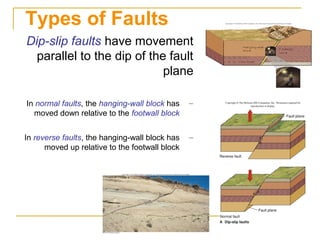Final fault new
- 2. Faults:Faults: Are fractures that have appreciable movement parallel to theirAre fractures that have appreciable movement parallel to their plane.plane. Faults may be hundred of meters or a few centimeters in length.Faults may be hundred of meters or a few centimeters in length. FAULTFAULT
- 3. Fault planeFault plane:: Surface that theSurface that the movement has taken placemovement has taken place within the fault. On thiswithin the fault. On this surface the dip and strike ofsurface the dip and strike of the fault is measured.the fault is measured. Hanging wall:Hanging wall: The rockThe rock mass resting on the faultmass resting on the fault plane.plane. Foot wall:Foot wall: The rock massThe rock mass beneath the fault plane.beneath the fault plane. Fault planeFault plane:: Surface that theSurface that the movement has taken placemovement has taken place within the fault. On thiswithin the fault. On this surface the dip and strike ofsurface the dip and strike of the fault is measured.the fault is measured. Hanging wall:Hanging wall: The rockThe rock mass resting on the faultmass resting on the fault plane.plane. Foot wall:Foot wall: The rock massThe rock mass beneath the fault plane.beneath the fault plane. Parts of The FaultsParts of The Faults
- 4. Separation:Separation: The amount ofThe amount of apparent offset of a faultedapparent offset of a faulted surface, measured in specifiedsurface, measured in specified direction. There are strikedirection. There are strike separation, dip separation, andseparation, dip separation, and net separation.net separation. Heave:Heave: The horizontalThe horizontal component of dip separationcomponent of dip separation measured perpendicular to strikemeasured perpendicular to strike of the fault.of the fault. Throw:Throw: The vertical componentThe vertical component measured in vertical planemeasured in vertical plane containing the dip.containing the dip.
- 5. Types of FAULTS A) SRIKE SLIP FAULT B) DIP SLIP FAULT
- 6. Types of Faults •Dip-slip faults have movement parallel to the dip of the fault plane –In normal faults, the hanging-wall block has moved down relative to the footwall block –In reverse faults, the hanging-wall block has moved up relative to the footwall block
- 7. Types of Faults •Dip-slip faults have movement parallel to the dip of the fault plane –Fault blocks, bounded by normal faults, that drop down or are uplifted are known as Grabens and HORSTS, respectively •Grabens associated with divergent plate boundaries are called rifts –Thrust faults are reverse faults with dip angles less than 30° from horizontal
- 9. Thrust FaultThrust Fault Thrust Faults: In the thrust faults the hanging wall has moved up relative to the footwall (dip angle 30º or less) Reverse Faults: Are similar to the thrust faults regarding the sense of motion but the dip angle of the fault plane is 45º or more Thrust faults usuallyThrust faults usually formed in areas offormed in areas of comperssional regime.comperssional regime.
- 11. Strike-Slip FaultStrike-Slip Fault Strike-slip Faults: Are faults that have movement along strikes. . Strike-SlipStrike-Slip FaultsFaults
- 12. Transform FaultsTransform FaultsTransform Faults:Transform Faults: Are aAre a type of strike-slip faulttype of strike-slip fault (defined by Wilson 1965).(defined by Wilson 1965). They form due toThey form due to thethe differences in motiondifferences in motion between lithosphericbetween lithospheric plates.plates. They are basically occurThey are basically occur where type of platewhere type of plate boundary isboundary is transformed intotransformed into anotheranother..
- 13. Faults
- 14. Faults
- 15. Faults
- 16. Faults
- 19. Different Type of Faults


















